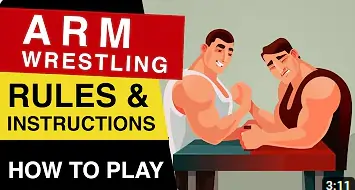The popular sport of arm wrestling pits two competitors against one another in a test of strength. Both players strive to pin the other’s arm to a flat surface to win the game. Pinching the opponent’s hand onto the touchpad of the table is the primary goal of arm wrestling. It can only be accomplished by combining ability, practice, and strength.
Arm Wrestling Table Dimensions
Arm Wrestling Table Dimensions : 91.5 x 66 cm(36*25.98in); Table height: 102 cm(40.15in); Structure profile: 50 x 50 cm(19.68*19.68in); Handles: steel, length: 15.2 cm(5.98in), diameter: 28 mm(1.1in);
Arm wrestling Elbow Pads
Arm wrestling elbow pads are protective gear designed to provide support and cushioning to the elbow and forearm area during arm wrestling matches. Arm wrestling is a physically demanding sport that involves intense pressure on the elbow joint and surrounding muscles. Elbow pads are essential to prevent injuries, bruises, and friction burns that can occur during arm wrestling competitions.
Arm wrestling Elbow Pad Dimensions
The dimensions of arm wrestling elbow pads can vary depending on the brand, style, and size of the pad. However, I can provide you with approximate dimensions that are typical for elbow pads used in arm wrestling. Keep in mind that these are general guidelines, and actual dimensions may vary.
Pads dimensions: 7 to 10in(18cm to 25cm)Pad Length, 4 to 6in (10cm to 15cm)Pad Width, 0.5 to 1 inch (1.3 to 2.5 centimeters)Thickness,
square, 7″ x 7″. 2 “thick, coated in a vinyl or rexin-type material, and built of substantial, high-quality foam. A 1/8″ metal sheet measuring 7″ by 7″ may be fastened to the foam and covering using two 1/4”-diameter threaded bolts “long and welded to the base so you can attach your elbow pads to the top of the table. At tournaments, a line will always be drawn from hand grip to hand grip, either painted, upholstered, or taped, to mark the middle of the table.
4″ high x 10″ long touch pads. Made of premium Touchpads
Elbow pads should be placed two inches from each edge. A right-arm table should overlap by half to the right of the centre, and for a left-arm table, by half to the left.
TOUCH PADS: The inside corner of the elbow pad should be 5″ from the inside corner of the pad, and the outside corner of the pad should be 1/2″ from the edge of the pad in question. It should be 2 3/4″ from the hand peg to the outer corner of the touchpad, measured running at an angle in the direction of the hand peg. These measurements should be taken on the left side of the elbow pad for a right-arm table and on the opposite side for a left-arm table.
HAND PEGS: Should be positioned 1″ in from the edge of the table, 13″ in from each edge, in the middle. The peg itself should have a diameter of 1″ and stand six inches off the tabletop.
TABLE FRAME: We always have four legs, and the inside frame must be at least 28″ wide and inside legs must be at least 18″ apart.
MATERIAL: Square tubing is the ideal material to utilize. However, you may also use a flat iron, angle iron, or tubular steel—but not all three at once “in widths or diameters. The typical material for the tabletop and seat top is 3/4 “hefty plywood. To add a cosy finished look, the tabletop and seat may have a thin sheet of foam covered in a vinyl/rexin-type material. The tabletop and chairs must not be covered in reflective tape or Plexiglas.
RISER PLATFORMS: Competitors who are at a height disadvantage can employ riser platforms. To lift the contestant, or at least raise their waist to the top of the table, riser platforms can be utilized in conjunction with platform shoes or numerous platforms. Prior to the event, competitors are permitted to utilize a personal riser with the Head Referee’s approval. Riser platforms will be manufactured of 1/2″ thick plywood, measuring 4″ high, 36″ wide, and 32″ deep, for consistency and handling convenience. To prevent them from falling out during the competition, they will be notched at the top portion so that they fit the table legs on each of their different sides. The notches on either side will be situated about 3″ from the top. To make it easier to remove and reinstall the riser platform, a hand slot will be cut out of the middle.
Arm-wrestling Federation World TABLES
- Table tops are upholstered and cushioned with 1/4″ foam.
- Elbow and pin pads are upholstered, high-density foam or rubber, fastened to the tabletop with screws or bolts.
- Upholstered and cushioned with 1/4″ foam is the seats of the sit-down tables.
- To preserve stability during competition, table frameworks should be composed of square or round tubing or pipe and attached firmly to plywood that is at least 1/2″ thick, 38″ broad, and 5′ long.
- The total measurements of all AAA/WAF table tops are 26 “38” wide x 38″ long with 1″ solid, round pegs put in 1″ from the table edge and 6″ high from the tabletop. Thirty-six inside measurements “length from one peg’s centre to the opposing peg’s centre.
- The dimensions of every AAA/WAF sit-down seat are 18″ square and 18″ height from floor to seat top.
Note: The specifications for the elbow and pin pads are for competition with the right hand. For left-handed competitors, reverse the location measurements.
FAQs
How do I get better at arm wrestling?
Arm wrestling practice is the greatest approach to improvement.
What are some workouts that improve arm strength for arm wrestling?
Work on your grip while performing sets of hook curls, wrist curls, and pull-ups. You may accomplish this by lifting while using fat grips. Include fat grips on your bar when performing any type of arm workout for a stronger forearm and grip.
Why do we see arm wrestlers using various weights and performing weird exercises?
Either there is no one to arm wrestle with (perhaps because they are too powerful for a typical male), or they wish to improve their stamina or strength is the response (or both).


